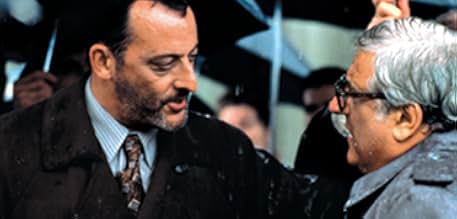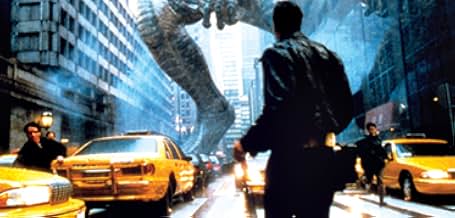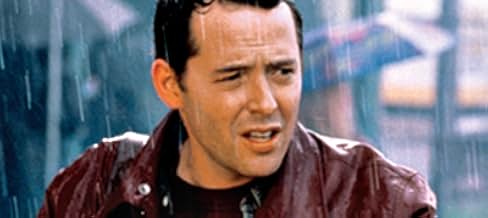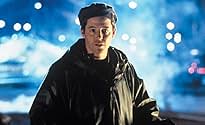Un gigantesco rettile mostruoso appare a New York e lascia una scia di devastazione. Un biologo, la sua ex-ragazza ed una serie di altri improbabili eroi devono fare del loro meglio per salv... Leggi tuttoUn gigantesco rettile mostruoso appare a New York e lascia una scia di devastazione. Un biologo, la sua ex-ragazza ed una serie di altri improbabili eroi devono fare del loro meglio per salvare la cittàUn gigantesco rettile mostruoso appare a New York e lascia una scia di devastazione. Un biologo, la sua ex-ragazza ed una serie di altri improbabili eroi devono fare del loro meglio per salvare la città
- Regia
- Sceneggiatura
- Star
- Premi
- 10 vittorie e 13 candidature totali
Recensioni in evidenza
The main criticism of this movie is that this Godzilla does not have the characteristics of his Japanese counterpart, which is true and valid. This Godzilla is not impervious to traditional weaponry, he runs and hides and uses stealth attacks instead of being a slow, lumbering wall of destruction, and his mighty atomic breath beam attack has been reduced to more of an oral flamethrower. But it is important to realize that a Godzilla movie had not been theatrically released in America for 14 years, the only way most Americans knew of Godzilla was through TV reruns and VHS tapes. He was simply not a major cultural force in America at that time. What was a major cultural force was Jurassic Park, so it makes sense that in order to create the largest draw possible, the filmmakers would reference Jurassic Park more than traditional Japanese monster movies, because that's what most audiences would be familiar with. Indeed, Godzilla and his offspring are more akin to a mutated T. Rex and raptors than to the big G himself. Also, the conception of giant movie monsters is fundamentally different in America vs Japan. In America, giant monsters are mutated animals on the loose, that cause a lot of violence before they are inevitably destroyed by military might or scientific ingenuity. In Japan, giant monsters (called kaiju) are immortal, indestructible, god-like beings. Japanese monster films operate much more in the realm of fantasy than their American counterparts. If Godzilla 1998 had gone for more of a traditional Japanese approach, wide audiences might not have understood it in the same way as they would a giant T. Rex run amok in NYC.
Forget expectations and cultural baggage. Watch this movie for what it is, and you will have a good time.
"Godzilla" (1998) is definitely not a bad guilty pleasure movie. It has pretty good special effects, nice pacing and some good action sequences involving Godzilla himself. Well its not entirely a Godzilla everyone knows, its more of a dinosaur but still its a good looking creature, especially when it interacts with environment (city buildings in this case). The downsides of this movie were pretty lame script at the moments, zero chemistry between Matthew Broderick and Maria Pitillo (and her poor performance as well) and just the look of this movie - literally almost all movie time action takes place at night, sure because its much more easier (and cheaper) to make all the big special effects sequences in a bloody dark, but not so much fun to watch it.
Overall, "Godzilla" is a guilty pleasure. As a pure fun flick it does its job, nothing else and nothing more. A pure guilty pleasure.
Five Godzilla Movies You Need to Watch
Five Godzilla Movies You Need to Watch
Lo sapevi?
- QuizThis movie features more Simpson voice actors than any other project besides I Simpson (1989) itself: Hank Azaria, Harry Shearer and Nancy Cartwright. When the Simpsons later did a Godzilla parody called Homerzilla, they referenced that "Homerzilla" received a Hollywood remake that failed, a jab at this movie. The episode ends stating that Homerzilla will one day return just as soon as that "Zilla" film is forgotten.
- BlooperBased on the width and depth of the Hudson River, it would be impossible for a Los Angeles Submarine to navigate submerged, let alone make high speed turns.
- Citazioni
Apache Pilot: [after accidentally hitting the Chrysler Building with a missile, blowing the roof off of it] Aw, damn, uh... That is a negative impact. I repeat, that is a negative impact.
Radio Technician #3: Negative impact, sir.
Mayor Ebert: [shocked] Negative impact? That's the goddamned Chrysler Building we're talking about here.
- Curiosità sui creditiA dedication to Godzilla creator Tomoyuki Tanaka appears towards the end of the credits.
- ConnessioniEdited into Angeli in America (2003)
- Colonne sonoreHeroes
Written by David Bowie & Brian Eno
Produced by Andrew Slater
Performed by The Wallflowers
Courtesy of Interscope Records
I più visti
Dettagli
- Data di uscita
- Paesi di origine
- Lingue
- Celebre anche come
- Quái Vật Godzilla
- Luoghi delle riprese
- Aziende produttrici
- Vedi altri crediti dell’azienda su IMDbPro
Botteghino
- Budget
- 130.000.000 USD (previsto)
- Lordo Stati Uniti e Canada
- 136.314.294 USD
- Fine settimana di apertura Stati Uniti e Canada
- 44.047.541 USD
- 24 mag 1998
- Lordo in tutto il mondo
- 379.014.294 USD
- Tempo di esecuzione
- 2h 19min(139 min)
- Colore
- Mix di suoni
- Proporzioni
- 2.39 : 1







































